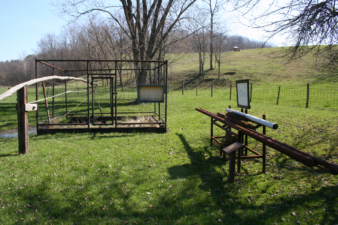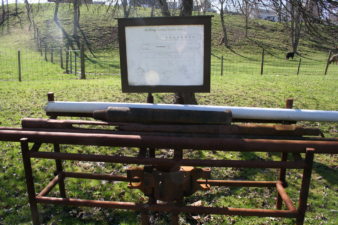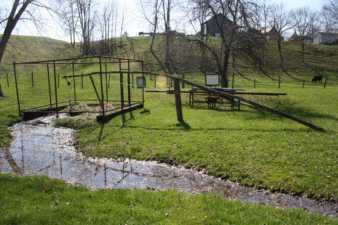The OES visited the Thorla-McKee Well on March 31, 2010. In 1814, frontier settlers Silas Thorla and Robert McKee decided to drill a well in search of valuable salt brine where they had observed a deer licking the ground. The well, cased with a hollow sycamore log, did produce salt brine as they had hoped, but it also produced oil and natural gas. This was more of a nuisance than a gold mine for the duo. Salt was an extremely important commodity for settlers as it was used to preserve meat, flavor food and raise livestock. Thorla and McKee used wool blankets to absorb the oil from the top of the salt water. The water was then boiled down until all that remained was salt. McKee suggested the oil could be burned in homes, but the thick smoke that burning oil produced prevented this. It wasn’t until 1859, when oil refining was perfected, that it was used in homes. After neighbors tasted the oil, they suggested that it be sold as a medicine. So Thorla and McKee wrung the oil from the blankets into bottles and sold it as a cure-all called “Seneca Oil.” Their operation came to an end in 1831 when fire destroyed the works built on the site. Although the Thorla-McKee Well was the first oil-producing well in North America, wells were not drilled seeking oil as a primary product until 1859, with the establishment of the Drake Well in Pennsylvania.
Today the site of the Thorla-McKee Well is a small park at the corner of State Route 78 and State Route 564, just outside the town of Caldwell. The well. complete with the original log casing, is now surrounded by a protective cage. It can still produce small amounts of salt brine and oil during extraction demonstrations that take place there occasionally. Caboose 33 and a flag station that were part of the Bellaire, Zanesville and Cincinnati Railroad are also located in the park, but are unrelated to the well.
Location Information: Public Park
The Thorla-McKee Well is located at the intersection of State Routes 78 and 564 near Caldwell; Noble County.













